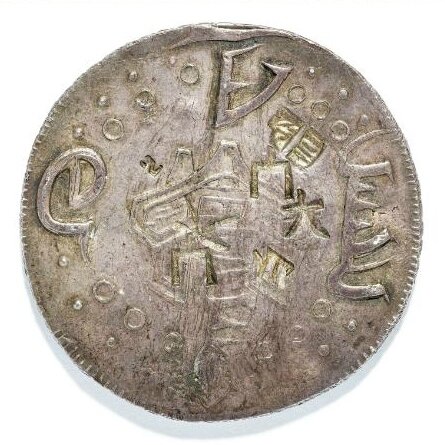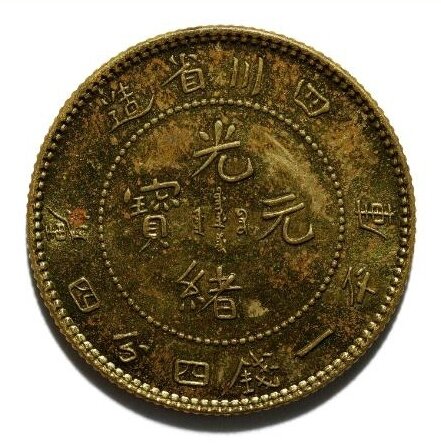East Asian coins on display at National Museum of American History
Dragon head bridge money, China, 5th–3rd century BCE. Acquired from the Howard F. Bowker Family. © Smithsonian’s National Museum of American History
WASHINGTON, DC.- The Smithsonian’s National Museum of American History is displaying selected numismatic objects recently acquired from the collection of Howard F. Bowker. The New Acquisitions case within the “Value of Money” exhibition shows 19 items ranging from fifth-century B.C. Chinese bridge and knife money to 20th-century Chinese money minted in the U.S.
The selection is part of a recent donation of more than 380 objects from the Bowker collection of East Asian coins, banknotes and stamps. The collection includes rare modern Chinese coinage such as a 500 cash coin made from copper and tin in 1927 and a silver “Old Man” dollar from 1837, as well as a wide variety of 19th- and 20th-century Japanese and Korean coinage.
"Old Man" Dollar Coin, China (Taiwan), 1837. One of the earliest Chinese struck silver coins. Gift of the Howard F. Bowker Family. © Smithsonian’s National Museum of American History
“The Bowker collection presents an ideal opportunity to explore what numismatic objects can reveal about the historic trade and technological connections between the United States and East Asia,” said Ellen Feingold, curator of the National Numismatic Collection.
A set of 1902 gilt brass-proof pattern coins also are included in this acquisition. These coins were struck in the U.S. by the Ferracute Machine Co. of Bridgeton, N.J. The coins contribute to the understanding of that connection and further illustrate the ties between North American and Chinese numismatics, economics and trade.
7 Mace and 2 Candareen Proof Pattern Coin, United States for China, 1902. Gift of the Howard F. Bowker Family. © Smithsonian’s National Museum of American History
The donation also includes 12 ancient Chinese knives and 20 pieces of ancient Chinese bridge money. Of the knives, seven are known as “Qi knives” and five are known as “Ming knives.” The newly acquired knives and bridge money will help the museum to tell the full narrative of Chinese numismatics through material culture.
Knife money, China, 5th to 1st century BCE. Gift of the Howard F. Bowker Family. © Smithsonian’s National Museum of American History
Bridge money, China, 5th–3rd century BCE. © Smithsonian’s National Museum of American History
Spade money, China, 4th–3rd century BCE, and Ban liang coin, China, around 3rd century BCE. © Smithsonian’s National Museum of American History
The museum recognizes the generosity of the Howard F. Bowker Family and Michael Chou for their support to promote research and enhanced public access of the National Numismatic Collection through exhibition and digitization efforts.
Bowker’s passion for collecting began when he was stationed as a U.S. naval officer in Hànkǒu, Hubei Province, China, following the end of World War I, and he collected more than 10,000 historic East Asian artifacts.
East Asian monetary objects have been a part of the Smithsonian’s National Numismatic Collection since the 19th century. Today, the National Numismatic Collection has strong East Asian representation and is a national resource for the study of East Asian money. The National Numismatic Collection opened the “The Value of Money” exhibition in July 2015, and it links American history to global histories of exchange, cultural interaction, political change and innovation. “The Value of Money” allows visitors to explore the origins of money, new monetary technologies, the political and cultural messages money conveys, numismatic art and design and the practice of collecting money.
Fen coin, China, 1937, and 20 fen coin, 1935. © Smithsonian’s National Museum of American History

/https%3A%2F%2Fprofilepics.canalblog.com%2Fprofilepics%2F1%2F0%2F100183.jpg)
/https%3A%2F%2Fstorage.canalblog.com%2F03%2F02%2F119589%2F96711876_o.jpg)
/https%3A%2F%2Fstorage.canalblog.com%2F11%2F31%2F119589%2F94773502_o.jpg)
/https%3A%2F%2Fstorage.canalblog.com%2F20%2F83%2F119589%2F94772815_o.jpg)
/https%3A%2F%2Fstorage.canalblog.com%2F26%2F72%2F119589%2F75604929_o.jpg)
/https%3A%2F%2Fstorage.canalblog.com%2F59%2F60%2F119589%2F26458628_o.jpg)











/image%2F1371349%2F20240418%2Fob_ac5c4c_telechargement.jpg)
/image%2F1371349%2F20240418%2Fob_709b64_304-1.jpg)
/image%2F1371349%2F20240418%2Fob_22f67e_303-1.jpg)
/image%2F1371349%2F20240417%2Fob_9708e8_telechargement.jpg)